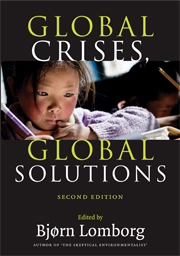Book contents
- Frontmatter
- Contents
- List of figures
- List of tables
- List of contributors
- Acknowledgements
- List of abbreviations and acronyms
- Introduction
- PART I THE CHALLENGES
- 1 Air pollution
- 2 The security challenge in conflict-prone countries
- 3 Disease control
- 4 The benefits and costs of alternative strategies to improve educational outcomes
- 5 Climate change
- 6 Hunger and malnutrition
- 7 Water and sanitation
- 8 The challenge of reducing international trade and migration barriers
- 9 Transnational terrorism
- 10 Women and development
- PART II RANKING THE OPPORTUNITIES
- Conclusion
7 - Water and sanitation
Published online by Cambridge University Press: 05 June 2012
- Frontmatter
- Contents
- List of figures
- List of tables
- List of contributors
- Acknowledgements
- List of abbreviations and acronyms
- Introduction
- PART I THE CHALLENGES
- 1 Air pollution
- 2 The security challenge in conflict-prone countries
- 3 Disease control
- 4 The benefits and costs of alternative strategies to improve educational outcomes
- 5 Climate change
- 6 Hunger and malnutrition
- 7 Water and sanitation
- 8 The challenge of reducing international trade and migration barriers
- 9 Transnational terrorism
- 10 Women and development
- PART II RANKING THE OPPORTUNITIES
- Conclusion
Summary
Introduction
The 1980s were designated the International Water and Sanitation Decade, and the international community committed itself to ensuring that everyone in the world would have access to at least basic water and sanitation services by 1990. This target was not met. While hundreds of millions did receive access to new services, at the end of the decade well over 1.1 billion people still lacked improved water supplies, and more than 2.7 billion lacked sanitation services. By the year 2000, although another billion people had obtained access to improved water and sanitation services, population growth had left the number of those still unserved at roughly the same absolute level. In 2002, at the Johannesburg World Summit on Sustainable Development, the global community made a new commitment to a set of Millennium Development Goals (MDGs), including environmental sustainability. One of the targets under the environmental sustainability MDG is to cut by half the proportion of people in the world living without access to water and sanitation by 2015.
While we certainly hope that the global target for water and sanitation will be met this time, there are grounds for concern. Some important physical and economic features of water supply and sanitation make it inherently difficult to achieve broad-scale goals such as those of the International Water and Sanitation Decade and the MDG water and sanitation target – more difficult than for other MDG targets such as providing access to affordable essential drugs or communication and information technology.
- Type
- Chapter
- Information
- Global Crises, Global SolutionsCosts and Benefits, pp. 355 - 450Publisher: Cambridge University PressPrint publication year: 2009
- 2
- Cited by

